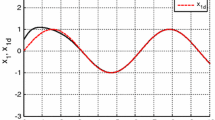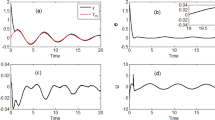Abstract
This article investigates a new fixed-time control scheme for a general class of nonlinear systems with high-order mismatched disturbances. An integral sliding mode surface is designed based on the estimations of the mismatched disturbances, which enables the control scheme to reject the mismatched disturbances. A continuous terminal sliding mode control law is then proposed, which guarantees that the convergence time is finite and independent of the initial conditions. Furthermore, the rigorous analysis for the fixed-time stability is presented with the bi-limit homogeneous property and Lyapunov theory. Finally, both the numerical simulations and the experimental tests are given to verify the superiority of the proposed fixed-time control scheme. The core of the proposed control scheme, which is developed with the nonsingular terminal sliding mode control (NTSMC) technique and fixed-time disturbance observer, ensures the fixed-time convergence and strong robustness to mismatched disturbances. The practical significance of the proposed control design is demonstrated by a real application to a crane system.











Similar content being viewed by others
Data availability
Data sharing is not applicable to this article.
References
Zuo, Z.: Nonsingular fixed-time consensus tracking for second-order multi-agent networks. Automatica 54, 305–309 (2015)
Zuo, Z., Song, J., Tian, B., Basin, M.: Robust fixed-time stabilization control of generic linear systems with mismatched disturbances. IEEE Trans. Syst. Man, and Cybernet.: Syst. 52(2), 759–768 (2022)
Yang, J., Sun, J., Zheng, W., Li, S.: Periodic event-triggered robust output feedback control for nonlinear uncertain systems with time-varying disturbance. Automatica 94, 324–333 (2018)
Utkin, I.: Sliding Modes in Control and Optimization. Springer Verlag, Berlin, Heidelberg (1992)
Fridman, L., Shtessel, Y., Edwards, C., Yan, X.G.: Higher-order sliding-mode observer for state estimation and input reconstruction in nonlinear systems. Int. J. Robust Nonlinear Control 18(4–5), 399–412 (2008)
Seeber, R.: Three counterexamples to recent results on finite- and fixed-time convergent controllers and observers. Automatica 112, 1–5 (2020)
Fang, X., Liu, F.: High-order mismatched disturbance rejection control for small-scale unmanned helicopter via continuous nonsingular terminal sliding-mode approach. Int. J. Robust Nonlinear Control 29(4), 935–948 (2019)
Qiao, L., Zhang, W.: Trajectory tracking control of auvs via adaptive fast nonsingular integral terminal sliding mode control. IEEE Trans. Industr. Inf. 16(2), 1248–1258 (2020)
Gurumurthy, G., Das, D.K.: Terminal sliding mode disturbance observer based adaptive super twisting sliding mode controller design for a class of nonlinear systems. Eur. J. Control. 57, 232–241 (2021)
Zhang, J., Zhang, N., Shen, G., Xia, Y.: Analysis and design of chattering-free discrete-time sliding mode control. Int. J. Robust Nonlinear Control 29(18), 6572–6581 (2019)
Lu, B., Fang, Y., Sun, N.: Continuous sliding mode control strategy for a class of nonlinear underactuated systems. IEEE Trans. Autom. Control 63(10), 3471–3478 (2018)
Cuong, H.M., Dong, H.Q., Trieu, P.V., Tuan, L.A.: Adaptive fractional-order terminal sliding mode control of rubber-tired gantry cranes with uncertainties and unknown disturbances. Mech. Syst. Signal Process. 154, 107601 (2021)
Cuong, H.M., Thai, N.V., Trieu, P.V., Dong, H.Q., Nam, T.T., Viet, T.X., Nho, L.C., Tuan, L.A.: Nonsingular fractional-order integral fast-terminal sliding mode control for underactuated shipboard cranes. J. Franklin Inst. 359, 6587–6606 (2022)
Andrieu, V., Praly, L., Astolfi, A.: Homogeneous approximation, recursive observer design, and output feedback. SIAM J. Control. Optim. 47(4), 1814–1850 (2008)
Tian, B., Lu, H., Zuo, Z., Wang, H.: Fixed-time stabilization of high-order integrator systems with mismatched disturbances. Nonlinear Dyn. 94(4), 2889–2899 (2018)
Polyakov, A.: Nonlinear feedback design for fixed-time stabilization of linear control systems. IEEE Trans. Autom. Control 57(8), 2106–2110 (2012)
Zuo, Z.: Non-singular fixed-time terminal sliding mode control of non-linear systems. IET Control Theory Appl. 9(4), 545–552 (2015)
Ni, J., Liu, L., Liu, C., Li, S.: Fast fixed-time nonsingular terminal sliding mode control and its application to chaos suppression in power system. IEEE Trans. Circuits Syst. II Express Briefs 64(2), 151–155 (2017)
Hou, H., Yu, X., Xu, L., Rsetam, K., Cai, Z.: Finite-time continuous terminal sliding mode control of servo motor systems. IEEE Trans. Industr. Electron. 67(7), 5647–5656 (2020)
Zuo, Z., Tian, B., Defoort, D., Ding, Z.: Fixed-time consensus tracking for multiagent systems with high-order integrator dynamics. IEEE Trans. Autom. Control 63(2), 563–570 (2018)
Yang, J., Li, S., Yu, X.: Sliding-mode control for systems with mismatched uncertainties via a disturbance observer. IEEE Trans. Industr. Electron. 60(1), 160–169 (2013)
Yang, J., Su, J., Li, S., Yu, X.: High-order mismatched disturbance compensation for motion control systems via a continuous dynamic sliding-mode approach. IEEE Trans. Industr. Inf. 10(1), 604–614 (2014)
Qian, Y., Hu, D., Chen, Y., Fang, Y.: Programming-based optimal learning sliding mode control for cooperative dual ship-mounted cranes against unmatched external disturbances. IEEE Transactions on Automation Science and Engineering; Early Access: 1–12 (2022)
Yang, J., Li, S., Su, J., Yu, X.: Continuous nonsingular terminal sliding mode control for systems with mismatched disturbances. Automatica 49, 2287–2291 (2013)
Zhang, L., Yang, J.: Continuous nonsingular terminal sliding mode control for nonlinear systems subject to mismatched terms. Asian J. Control 24(2), 885–894 (2020)
Rauf, A., Zafran, M., Khan, A., Tariq, A.R.: Finite-time nonsingular terminal sliding mode control of converter-driven DC motor system subject to unmatched disturbances. Int. Trans. Electric. Energy Syst. 31(11), e13070 (2021)
Razzaghian, A., Moghaddam, R.K., Pariz, N.: Fractional-order nonsingular terminal sliding mode control via a disturbance observer for a class of nonlinear systems with mismatched disturbances. J. Vib. Control 27(1–2), 140–151 (2021)
Razzaghian, A., Moghaddam, R.K., Pariz, N.: Disturbance observer-based fractional-order nonlinear sliding mode control for a class of fractional-order systems with matched and mismatched disturbances. Int. J. Dynam. Control 9, 671–678 (2021)
Chen, W.-H.: Disturbance observer-based control for nonlinear systems. IEEE/ASME Trans. Mechatron. 9(4), 706–710 (2003)
Shtessel, Y., Shkolnikov, I., Levant, A.: Smooth second-order sliding mode: missile guidance application. Automatica 43(8), 1470–1476 (2007)
Angulo, M., Moreno, J., Fridman, L.: Robust exact uniformly convergent arbitrary order differentiator. Automatica 49(8), 2489–2495 (2013)
Filippov, A.: Differential Equations with Discontinuous Right-Hand Side. The Netherlands, Kluwer, Dordrecht (1988)
Angulo, M., Moreno, J., Fridman, L.: Robust exact uniformly convergent arbitrary order differentiator. Automatica 49(8), 2489–2495 (2013)
Chen, M., Wang, H., Liu, X.: Adaptive fuzzy practical fixed-time tracking control of nonlinear systems. IEEE Trans. Fuzzy Syst. 29(3), 664–673 (2021)
Basin, M., Shtessel, Y., Aldukali, F.: Continuous finite- and fixed-time high-order regulators. J. Franklin Inst. 353, 5001–5012 (2016)
Wie, B., Bernstein, D.: Benchmark problems for robust control design. American Control Conference; San Diego, CA, USA: 2047–2048 (1990)
Zong, Q., Zhao, Z., Zhang, J.: High-order sliding mode control with self-tuning law based on integral sliding mode. IET Control Theory Appl. 4(7), 1282–1289 (2008)
Chen, H., Fang, Y., Sun, N.: An adaptive tracking control method with swing suppression for 4-DOF tower crane systems. Mech. Syst. Signal Process. 123, 426–442 (2019)
Yang, T., Sun, N., Chen, H., Fang, Y.: Motion trajectory-based transportation con for 3-d boom cranes: analysis, design, and experiments. IEEE Trans. Industr. Electron. 66(5), 3636–3646 (2019)
Sun, N., Fang, Y., Chen, H.: A new antiswing control method for underactuated cranes with unmodeled uncertainties: theoretical design and hardware experiments. IEEE Trans. Industr. Electron. 62(1), 453–465 (2015)
Lu, B., Fang, Y., Sun, N.: Sliding mode control for underactuated overhead cranes suffering from both matched and unmatched disturbances. Mechatronics 47, 116–125 (2017)
Chen, J.C.L., Lee, T.H., Tan, C.P.: A sliding mode observer for robust fault reconstruction in a class of nonlinear non-infinitely observable descriptor systems. Nonlinear Dyn. 101, 1023–1036 (2020)
Sun, J., Pu, Z., Yi, J., Liu, Z.: Fixed-time control with uncertainty and measurement noise suppression for hypersonic vehicles via augmented sliding mode observers. IEEE Trans. Industr. Inf. 16(2), 1192–1203 (2020)
Yang, F., Wei, C., Wu, R., Cui, N.: Non-recursive fixed-time convergence observer and extended state observer. IEEE Access 6, 62339–62351 (2018)
Funding
This work is supported by the National Natural Science Foundation of China under grants 62273165, 61833007, the China Postdoctoral Science Foundation under Grants 2021M702505, 2023T160493, and the 111 Project under Grants B23008.
Author information
Authors and Affiliations
Corresponding author
Ethics declarations
Conflict of interest
The authors declared that they have no conflicts of interest to this work.
Additional information
Publisher's Note
Springer Nature remains neutral with regard to jurisdictional claims in published maps and institutional affiliations.
Appendix
Appendix
Proof of Theorem 1
Define the estimation errors \(e_i^0 = z_i^0 - x_i\) and \(e_i^j = z_i^j - d_i^{(j-1)}\) for \(i=1,\cdots ,n\) and \(j=1,\cdots ,\ell _i\).
The error dynamics of the disturbance observer (2) is formulated by
The compact expression of the error system (23) can be rewritten by
where the error vector \(e_i=[e_i^0,\ldots ,e_i^{\ell _i}]^T\), the functional vector \(f_i(e_i) =[f_i^0(e_i),\ldots ,f_i^{\ell _i}(e_i)]^T\) with \(f_i^{j}(e_i) = e_i^{j+1} - \lambda _i^j {\big \lceil {e_i^0} \big \rfloor ^{\alpha _i^j}} - \gamma _i^j \big \lceil {e_i^0 } \big \rfloor ^{\beta _i^j} \) for \(j=0,\cdots ,\ell _i-1\), and \(f_i^{\ell _i}(e_i) = - \lambda _i^{\ell _i} {\big \lceil {e_i^0} \big \rfloor ^{\alpha _i^{\ell _i}}} - \gamma _i^{\ell _i} \big \lceil {e_i^0 } \big \rfloor ^{\beta _i^{\ell _i}} \), and the disturbance vector \(D_i = [0,\ldots ,0,- d_i^{(\ell _i)}]^T\).
The subsequent proof will be presented with two steps. First of all, the stability of undisturbed error system (24) will be discussed, i.e., \(D_i=0\). Then, the fixed-time convergence of complete error dynamic system (24) will be investigated, i.e., \(D_i\ne 0\).
Step 1: It follows from [14] that the vector field \( f_i(e_i)\) is bi-limit homogeneous with associated triples \((r_{i,0},k_{i,0},f_{i,0})\) and \((r_{i,\infty },k_{i,\infty },f_{i,\infty })\), where \(r_{i,0}=[1,\alpha _i,\cdots ,\ell _i\alpha _i-(\ell _i-1)]\), \(r_{i,\infty }=[1,\beta _i,\cdots ,\ell _i\beta _i-(\ell _i-1)]\), \(k_{i,0}=\alpha _i-1\), \(k_{i,\infty }=\beta _i-1\), and the approximating vector fields are selected as
According to [43], we can obtain that \(\dot{e}_i =f_{i,0}(e_i)\), \(\dot{e}_i =f_{i,\infty }(e_i)\), and \(\dot{e}_i =f_{i}(e_i)\) are globally asymptotically stable. Furthermore, it follows from [14] that the states of the system \(\dot{e}_i =f_{i}(e_i)\) will converge to the origin within a fixed time. Additionally, according to [44], there exists a well-defined Lyapunov function \(V_i(e_i)\) and a real constant \(p>0\), such that the time derivative along the dynamics \(\dot{e}_i =f_{i}(e_i)\) satisfies
for real numbers \(k_{i,V_0}\ge \textrm{max}\{1,\alpha _i,\cdots ,\ell _i\alpha _i-(\ell _i-1)\}\) and \(k_{i,V_\infty }\ge \textrm{max} \{1,\beta _i,\cdots , \ell _i\beta _i-(\ell _i-1)\}\).
Step 2: Let us reconsider the disturbance \(D_i\). The time derivative of \(V_i(e_i)\) along the error dynamics (24) can be presented by
According to the Theorem 1 of [44], we can find a real constant \(q>0\) to satisfy
where \([r_{i,0}]_{\ell _i+1}\) and \([r_{i,\infty }]_{\ell _i+1}\) denote the \((\ell _i+1)\)-th element of \(r_{i,0}\) and \(r_{i,\infty }\), respectively.
Combining (26) and (28), and considering the dominant scopes of two power functions, we have
for \(V_i(e_i)\ge 1\), and
for \(V_i(e_i)\le 1\).
Define two constants \(c_1= (\frac{2qL_i}{p})^\frac{k_{i,V_\infty } k_{i,V_0}}{k_{i,V_\infty }k_{i,0} +k_{i,V_0}[r_{i,\infty }]_{\ell _i+1}} \) and \(c_2= (\frac{2qL_i}{p})^\frac{k_{i,V_0} k_{i,V_\infty }}{k_{i,V_0}k_{i,\infty } +k_{i,V_\infty }[r_{i,0}]_{\ell _i+1}}\).
For the clarity of presentation, the following analysis will be given with two cases.
Case 1: If the Lipschitz constant \(L_i\) satisfies \(\frac{2qL_i}{p}\ge 1\), then \(c_1\ge 1\) and \(c_2\ge 1\). According to the inequality (30), we have
Define a set
Therefore, if the initial value of estimation error \(e_i\) is at the outside of the set \(S_1\), then \(e_i\) will converge into \(S_1\) in a finite settling time \(T_{o1} = \frac{1}{p}\frac{k_{i,V_\infty }}{k_{i,\infty }} c_1 ^{-\frac{k_{i,\infty }}{k_{i,V_\infty }}}\), which is independent of initial conditions.
Case 2: If the Lipschitz constant \(L_i\) satisfies \(\frac{2qL_i}{p} < 1\), then we have
Define a set
Therefore, if the initial value of estimation error \(e_i\) is at the outside of the set \(S_2\), then \(e_i\) will converge into \(S_2\) in a finite settling time \(T_{o2} = \frac{1}{p} (\frac{k_{i,V_\infty }}{k_{i,\infty }} + \frac{k_{i,V_0}}{|k_{i,0}|})\), which is also independent of initial conditions.
To sum up, the disturbance estimation error \(e_i\) can converge to the small neighborhood of the origin in a finite settling time \(T_o= \textrm{max} \{T_{o1},T_{o2} \}\). \(\square \)
Rights and permissions
Springer Nature or its licensor (e.g. a society or other partner) holds exclusive rights to this article under a publishing agreement with the author(s) or other rightsholder(s); author self-archiving of the accepted manuscript version of this article is solely governed by the terms of such publishing agreement and applicable law.
About this article
Cite this article
Fang, X., Zhong, Q., Liu, F. et al. Fixed-time nonsingular terminal sliding mode control for a class of nonlinear systems with mismatched disturbances and its applications. Nonlinear Dyn 111, 21065–21077 (2023). https://doi.org/10.1007/s11071-023-08970-1
Received:
Accepted:
Published:
Issue Date:
DOI: https://doi.org/10.1007/s11071-023-08970-1




